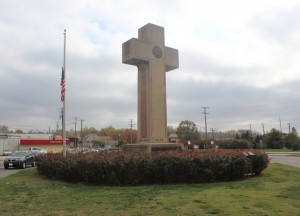Why We Sued Bladensburg, MD Over a 40-Foot Cross
 The 40-feet high "Peace Cross" in Bladensburg, MD.
The 40-feet high "Peace Cross" in Bladensburg, MD. At the core of the First Amendment’s Establishment Clause is the principle that the government must not favor or prefer some religions over others, or religion over non-religion. No matter how small the preference may seem to some, particularly to adherents of the favored religion, the framers of the Constitution believed that “The breach of neutrality that is today a trickling stream may all too soon become a raging torrent.”
When the government erects an exclusively Christian monument on government property, it violates this central command of the Establishment Clause by sending a clear message that Christianity is the preferred religion over all others. When the religious monument is dedicated to fallen soldiers, it sends an even more egregious message that only Christian soldiers are worth memorializing. Non-Christian soldiers such as atheists and humanists are inherently excluded.
Such is the case with a cross in Bladensburg, Maryland, commonly known as the “Peace Cross,” which stands forty-feet high on a government-owned median between roadways. In addition to the obvious sectarian nature of the Latin cross, the Bladensburg cross was also erected with religious motives.
In 1918, the Prince George’s County Memorial Committee began to raise funds to construct the cross. Contributors signed the following pledge: “We, the citizens of Maryland, trusting in God, the Supreme Ruler of the universe, pledge faith in our brothers who gave their all in the world war to make the world safe for democracy. Their mortal bodies have turned to dust, but their spirit lives to guide us through life in the way of godliness, justice and liberty. With our motto, ‘One God, One Country and one Flag,’ we contribute to this memorial cross commemorating the memory of those who have not died in vain.”
The Bladensburg cross was formally dedicated on July 12, 1925. As part of the dedication ceremonies, Representative Stephen W. Gambrill of the Fifth Maryland District delivered the dedication address, in which he stated: “You men of Prince Georges County fought for the sacred right of all to live in peace and security and by the token of this cross, symbolic of Calvary, let us keep fresh the memory of our boys who died for a righteous cause.”1 An invocation was given by Rev. A.J. Carey, pastor of St. Jerome’s Catholic Church. Rev. B.P. Robertson, pastor of the First Baptist Church pronounced a benediction.
The Bladensburg cross thus carries an inherently religious message and creates the unmistakable appearance of honoring only Christian servicemen. Ruling that a similar monumental cross in California violated the Establishment Clause, the Ninth Circuit reasoned that by “claiming to honor all service members with a symbol that is intrinsically connected to a particular religion,” the government is sending a “stigmatic message to non-adherents ‘that they are outsiders, not full members of the political community, and an accompanying message to adherents that they are insiders, favored members’” of the community. Trunk v. City of San Diego, 629 F.3d 1099, 1109, 1125 (9th Cir. 2011), cert. denied, 132 S. Ct. 2535 (2012).
In seeking the removal of the Bladensburg cross, the American Humanist Association seeks only to eliminate this stigmatic message to non-adherents of Christianity. It urges the government to erect an inclusive monument that will honor all fallen soldiers, regardless of their faith.
[1] Legion Dedicates Bladensburg War Memorial Cross, The Washington Post; July 13, 1925.
